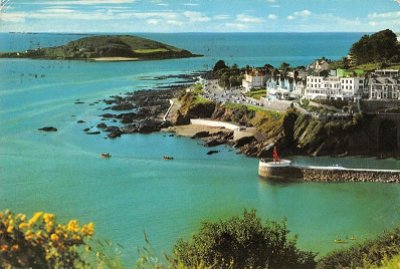


A gem of an island
Web: www.looeisland.co.uk
Web: www.cornwallwildlifetrust.org.uk
Looe Island also known as St. George's Island, and historically St. Michael's Island is a small island a mile from the mainland town of Looe.
According to local legend, Joseph of Arimathea landed here with the Christ Child. Some scholars, including Glyn Lewis, suggest the island could be Ictis, the location described by Diodorus Siculus as a centre for the tin trade in pre-Roman Britain.
The island is now owned and managed by the Cornwall Wildlife Trust charity where access is carefully managed for the benefit of wildlife and landing is only possible via the Cornwall Wildlife Trust authorized boatman. The waters around the island are a marine nature reserve and form part of the Looe Voluntary Marine Conservation Area (VMCA). First established in 1995, the Looe VCMA covers nearly three miles of coastline and aims to protect the coastal and marine wildlife around Looe.
People have been living on Looe Island since the Iron Age. Evidence of early habitation includes pieces of Roman amphorae as well as stone boat anchors and Roman coins. In the Dark Ages, the island was used a seat of early Christian settlement. The child Jesus was believed to have visited the Island with his uncle, Joseph of Arimathea, who traded with the Cornish tin traders. Therefore, Looe Island became a place of pilgrimage for early Christians and a small thatched roofed chapel was built there during this time.
In the later medieval period, the island came under the overall control of Glastonbury Abbey, with the Prior of Lammana being directly responsible for its governance; the island's chapel was under the care of two Benedictine monks until 1289 when the property was sold to a local landowner. The priory was replaced by a domestic chapel served by a secular priest until the Dissolution of the Monasteries in 1536 when it became property of the Crown. From the 13th to the 16th centuries it was known as St. Michael's Island but after the dissolution of the monasteries, it was rededicated in 1594 as St. George's Island.
Through the 17th and 18th centuries the island was used by smugglers to avoid the British Government's revenue cutters out of Plymouth and Falmouth. The Old Guildhall Museum in Looe hold information and research about the smuggling families of Looe Island and information is also available in the more recent publications about the island.
In 1965 Looe Island was purchased (and inhabited) by two sisters, Babs and Evelyn Atkins, who wrote two books: 'We Bought An Island' and its sequel 'Tales From Our Cornish Island'. They chronicle the purchase of the island and what it was like to live there. Evelyn died in 1997 at the age of 87; Babs continued to live on the island until her death in 2004, at the age of 86. On her death, the island was bequeathed to the Cornwall Wildlife Trust; it will be preserved as a nature reserve in perpetuity. The adjoining islet, formerly known as Little Island, now renamed Trelawny Island and connected by a small bridge, was bequeathed by Miss Atkins back to the Trelawny family, who previously owned Looe Island from 1743 to 1921.
Situated in the English Channel, about one mile from East Looe in the direction of Polperro, it is about 22.5 acres in area and a mile in circumference. Its highest point is 154 feet above sea level. Looe Island, like much of south-west England, has a mild climate with frost and snow being rare.
The island is owned and managed by the Cornwall Wildlife Trust. This is a non-profit-making venture, the landing fees and other income being devoted to conserving the island's natural environment and providing facilities. The island is open during the summer to day visitors arriving by the Trust's boat. After a short welcome talk visitors are directed to the small visitor centre from where they can pick up a copy of the self-guided trail. Visitors have some two hours on the island and all trips are subject to tides and weather/sea state. While it is normally accessible only by the Cornwall Wildlife Trust's boat, at extremely low spring tides it is possible for the journey to be made by foot across the slippery, seaweed-covered rocky sea floor. However you have to remain on the beach and promptly head back to the mainland.
In 2008, Channel 4's archaeology series Time Team visited the island to carry out an investigation into its early Christian history. They excavated the sites of Christian chapels built on both the island and on the mainland opposite. During their dig they found the remains of a Benedictine Lammana Chapel that was built in c.1139 by monks from Glastonbury Abbey, a reliquary, graves and the remains of much earlier Anglo-Romano places of worship built of wood with dating evidence suggesting use by Christians before the reign of Constantine the Great.
In 1994/95 Andrew Hugill composed Island Symphony, an electro-acoustic piece utilising sampled sounds sourced over the net plus recorded natural sounds from the island itself.
Cornwall's Wildlife Looe Polperro The Coastal Footpath